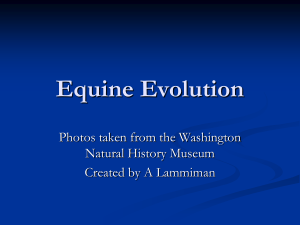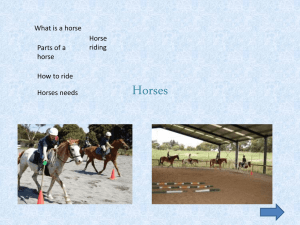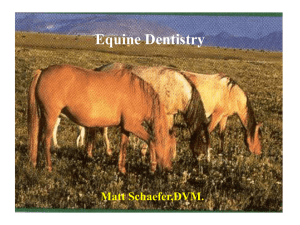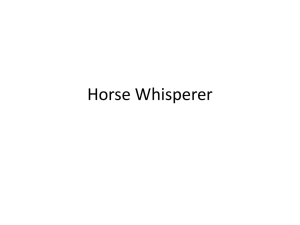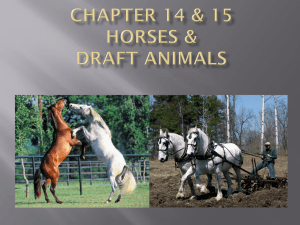Coggins Test
advertisement
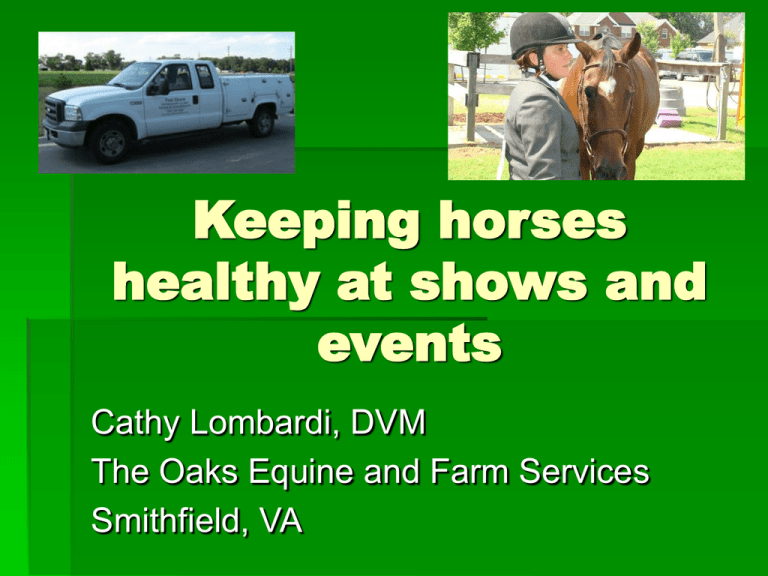
Keeping horses healthy at shows and events Cathy Lombardi, DVM The Oaks Equine and Farm Services Smithfield, VA Vaccines Coggins testing Setting up a first aid kit Safety at shows, trail rides and other events Questions Core Vaccines Vaccines that all horses should receive whether or not they leave your property Diseases that are usually very serious or even fatal Horse contracts disease from mosquitoes (EEE,WEE,WNV), wildlife (rabies) or environment (tetanus) Viral encephalitis Caused by Eastern Equine Encephalitis virus (EEE), Western Equine Encephalitis virus (WEE) or West Nile Virus (WNV) EEE is the most serious and most horses that contract EEE die or are euthanized EEE is VERY COMMON in unvaccinated horses in this area EEE, WEE and WNV all have similar signs Signs of EEE Fever Severe depression (“sleeping sickness”) Ataxia (drunk, uncoordinated, fall down) Seizure Blind 95% fatality rate! ALL HORSES MUST BE VACCINATED EVERY 6 MONTHS FOR EEE! WEE Signs are identical to EEE, but chance of survival is higher (20-50% die) ALL HORSES IN THIS AREA SHOULD BE VACCINATED EVERY 6 MONTHS West Nile Virus First seen in the US in horses in 1999 Fever, ataxia, circling, depression Muscle twitching in muzzle, neck and chest are common 30% horses with WNV die Treatment is supportive care (fluids, antiinflammatories) and can be costly ($1500 and up) ALL HORSES SHOULD BE VACCINATED EVERY 6 MONTHS Rabies Contracted from wildlife biting horse Rare that bite wound is seen Uncommon disease, but because of public health concern important to vaccinate Usually takes the “dumb” form ALL HORSES SHOULD BE VACCINATED ONCE A YEAR FOR RABIES Tetanus Caused by a bacteria in the environment C. tetani Sawhorse stance, lock jaw Wounds, surgical sites (castrations), stepping on nails ALL HORSES MUST BE VACCINATED AT LEAST ONCE A YEAR AND BOOSTERED AT TIME OF INJURY OR SURGERY What if my horses leave the property? Concerned about disease that they can catch from other horses Influenza (Flu) Rhinopneumonitis (Rhino) Strangles (Strep equi) All respiratory diseases spread by direct contact or aerosol from horse coughing or sneezing Flu and Rhino Viral respiratory diseases Runny nose, cough, fever, lethargic, off feed Spread by aerosol VACCINES FOR FLU/RHINO SHOULD BE GIVEN EVERY 4-6 MONTHS Strangles Highly contageous bacterial infection of upper respiratory tract Nasal discharge, fever, off feed, lethargy, enlarged abscessed lymph nodes Can survive on wood for 7-9 weeks, water for 6 weeks (DON’T USE COMMUNAL WATER TANKS) Intra-nasal vaccine given annually may prevent or lessen signs Strangles Other vaccines Botulism Found in soil, roundbales, rotting vegetation Shaker foal syndrome Vaccine only protects against 1 type “B” (3 shots initially then once a year) Potomac Horse Fever Diarrhea, laminitis Vaccine lessens signs, may not prevent Every 6 months Pneumabort Herpes virus – abortions in mares, 5, 7 and 9 months of gestation Should I do my own vaccines? Anyone can learn to give a shot, the concern is how the vaccine has been handled and stored prior to giving it We have seen vaccine failures in owner administered vaccines that were purchased from on-line stores Seen outdated vaccine sold at tack stores Annual visit allows us to examine the horse, give advice on feeding and husbandry Coggins Test For Equine Infectious Anemia Fatal disease that has no treatment Horses may have no symptoms but can spread it to other horses through biting insects, reused needles If positive horse is found, euthanasia or lifetime quarantine from other horses is required b) No equine more than six months of age shall be sold, offered for sale, traded, given away, or moved for the purpose of change of ownership unless accompanied by the original official negative test for EIA administered within 12 months prior to sale or movement, except that equine which are offered for sale at auction markets or sales may have a blood sample drawn at the market by the market's veterinarian at the seller's expense. In such cases, the equine may be sold and transferred contingent upon receipt of an official negative EIA test. Until receipt of an official negative EIA test, the equine must be isolated in accordance with standards for isolation of positive reactors, pursuant to 2 NCAC 52B .0408(c)(2). (c) All equine brought to or kept at any public stables or other public place for exhibition, recreation or assembly shall be accompanied by either the original or a copy of an official negative test for EIA administered within the previous 12 months. The owner, operator or person in charge of any public stables or other public place where equine are brought or kept for exhibition, recreation or assembly shall not permit an equine to remain on the premises without the test required by this Rule. FIRST AID KIT - Basic Thermometer (+/- stethoscope) Wound Care (roll gauze, vet wrap, clean towels, non stick pads, exam gloves) Sharp knife Rasp and pliers to pull shoe Duct tape and elastikon OTC meds (triple antibiotic ointment, benadryl) Safety on the road Make sure trailers are well maintained Tires (wear and pressure) Floorboards (rotting) Lights work (add reflective markers) Breaks, Safety chains, etc Hauling horses safely Leather or break-away halters Tie at appropriate length If hauling 1 horse, put in left side Do up butt bar before tieing horse Never load or tie horse to unhitched trailer Supervise horses when tied to outside of trailer – make sure ramp is up Have knife handy in case of accident What to keep with you Copy of coggins test Health Certificate if traveling out of state First Aid kit Water from home if horse is picky Hammer if stalling overnight to pound in protruding nails, etc. Safety at events Pay attention to horses around you! If your horse tends to kick out at other horses use a red ribbon in tail to alert others Avoid common water troughs Avoid overheating by finding shade, offering water frequently Try to get vaccines about 3 weeks prior to your “season” starting Questions?
